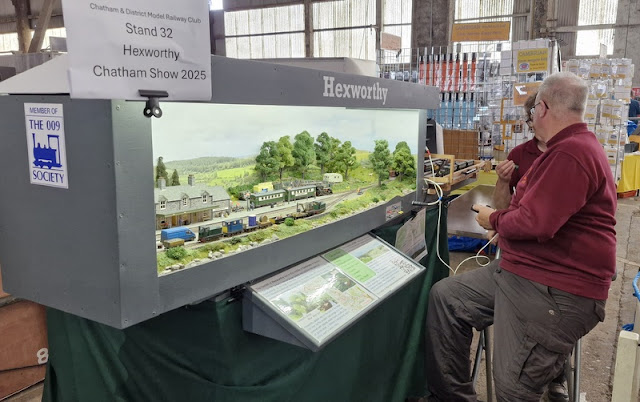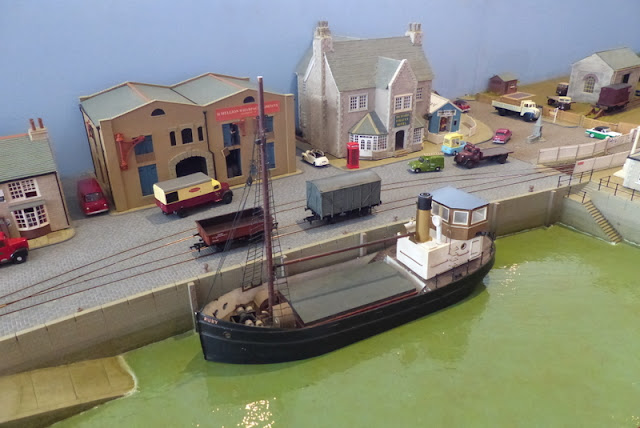This weekend I was at the Chatham show with Hexworthy. I can't do shows without help, so a big thanks to John Crane helping on Saturday and Mike Fox on Sunday. Here's Mike operating the layout.
I've never been to the Chatham show before, it's held in the historic dockyard which I'd visited with the family some years ago. With about 30 layouts and lots of trade it's a big show, and seemed well organised.
The venue is one of the old shipbuilding sheds, normally used as a car park, so it was large, a little draughty and dusty, rather dark (despite the phone photo), but fortunately given the heavy rain on Saturday, mostly free of leaks. The aisles were wide so exhibitors could drive in and unload (handy in the rain) and meant plenty of space for the crowds.
Outside this lovely little loco was doing "driver for a tenner" duties. Inside between the many traders (lots selling very similar stuff) there were around 30 layouts, so something for everyone. Here's just a few that caught my eye.
Across the hall was Bill Flude with his delightful O9 layout Bunkers Lane.
I am jealous of the open uncluttered feel of Leysdown of the Sheppey Light Railway by Adrian Colenutt in P4, but then it is a big layout for a simple terminus. Many might have been tempted to squeeze more in.
This WW1 train ferry is part of a model of Richborough Port in 1918 in N gauge by River MRC. The detail was fantastic, lighting and a backscene would have really helped though!
This was an impressive model of the Royal Albert Bridge in N gauge by the Basingstoke and North Hants MRS. Apparently it was part of a Great Model Railway Challenge TV show layout.
James Street is a huge N gauge layout, viewable on all 4 sides and with no fiddle yard. There's a lot of track and so always something running, you might think this would make for an unrealistic layout, but no. The modelling is really impressive, especially given the size of the layout, look at the detail of those boats and the dockyards and the rows of houses. The subtle colouring and high standard of modelling means it's hard to believe it is N, and it seemed to run as well as it looked too.
This is a model of the Bowaters Paper Mill Railway, which was a 2' 6" gauge railway linking paper mills at Sittingborne and Kemsley and Ridham dock in Kent, and is now partly preserved. The model is in O16.5 by St Neots MRC. The setting is one of the paper mills, the buildings are highly detailed including interiors - look at the mess building on the left.
The locos have really captured the presence and atmosphere of the prototypes, as do the wagons loaded with paper rolls. Just the right amount of weathering too.
The lighting varied from day to night, although I thought the tone a bit odd and sadly it threw the front of the models into shadow, it did give an overcast feel that was quite effective.
Probably the biggest "wow" factor was the Lego "Brick Coast Main Line" by the Lego UK Railway group - this model of the Forth railway bridge must have stood over 4' tall and was hugely impressive. The trains were impressively detailed too - remember, this is all made from Lego.
I was surprised to be presented with a trophy for (third) best layout! How good is that? There was a judging panel so this is the choice of railway modellers. Hexworthy got lots of nice comments so people seemed to like it - especially the playground of course - and a few enquiries about exhibitions too.



























